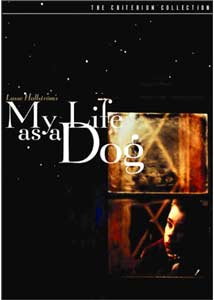My Life as a Dog
 Lasse Hallstrom’s My Life as a Dog (1985) is an interesting film in that it is alternately touching and maddening brainless. This latter quality is thankfully only truly embedded in the opening fifteen minutes, as our protagonist young Ingemar, commits every sin imaginable to further destroy his ailing mother’s health. Whether it’s getting his penis stuck in a glass bottle, accidentally setting whole trash heaps on fire, or knocking over dinner preparations after getting in a fight with his older brother, everything is manipulated to garner the deepest trauma to his mother even as young Ingemar looks on in bewilderment. Yet Hallstrom’s staging of it all feels overly designed to ratchet up the sympathy for the uncomprehending Ingemar, which soon becomes ludicrous.
Lasse Hallstrom’s My Life as a Dog (1985) is an interesting film in that it is alternately touching and maddening brainless. This latter quality is thankfully only truly embedded in the opening fifteen minutes, as our protagonist young Ingemar, commits every sin imaginable to further destroy his ailing mother’s health. Whether it’s getting his penis stuck in a glass bottle, accidentally setting whole trash heaps on fire, or knocking over dinner preparations after getting in a fight with his older brother, everything is manipulated to garner the deepest trauma to his mother even as young Ingemar looks on in bewilderment. Yet Hallstrom’s staging of it all feels overly designed to ratchet up the sympathy for the uncomprehending Ingemar, which soon becomes ludicrous.Thankfully, Hallstrom transitions out of these scenes quickly enough and allows a more appreciating sense of childhood and growing maturity to develop. Once Ingemar is shipped over to live with his uncle, most of the cloying material evaporates and a more honest and credible story begins to take shape, documenting Ingemar’s ascent into adulthood and introspection, even as he still grapples with family responsibility and his affection for the young adolescent girl, Saga, who masquerades as a boy because she enjoys it more.
Ingemar’s coping mechanisms for all the loss in his life is through displacement, through a gradual process of introjecting his traumas and matching them against larger traumas known worldwide. Thus, he avoids his issues by finding appeasement that his life isn’t the catastrophe of others. However, when he realizes that his beloved dog Sickan is dead, attacked with this knowledge by an avenging Saga who wishes to injure him with the same dislocation he attacked her with earlier, his resolve in holding life’s traumas at arm’s length disintegrates and he is finally overwhelmed. Here and elsewhere toward the end, the film avoids the cloying sensibilities that permeate the earlier sections, though the film does have a tendency to rely on the sugar more than it needs.
Regardless, Hallstrom’s direction and mise en scene are bathed in a sense of beatific wonder at the beauty of 1950s Sweden, even as it hints subtly at fissures rupturing the commoners in Sweden. While Hallstrom circumvents some of the more traumatic issues by sustaining a comedic tone, the film overall succeeds because the characters eventually are fully drawn and developed. Thus, even at cloying moments the characters are actually consistent, even if they are consistently average. Overall, the film works for me, but not on any superlative level.
My Life as a Dog: 6.5/10

0 Comments:
Post a Comment
<< Home